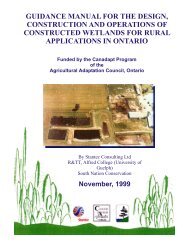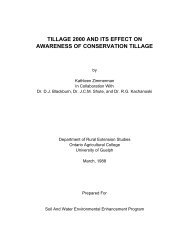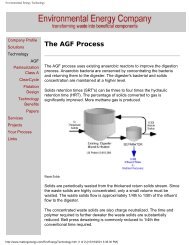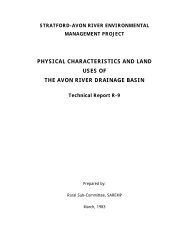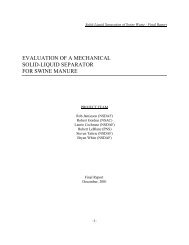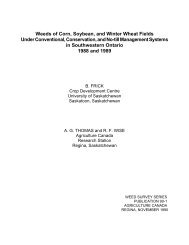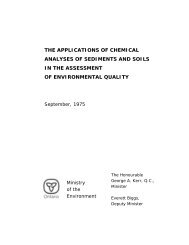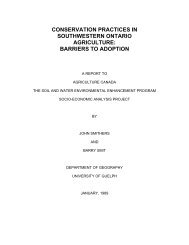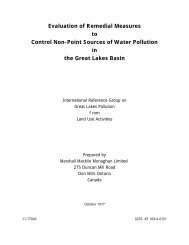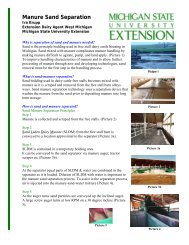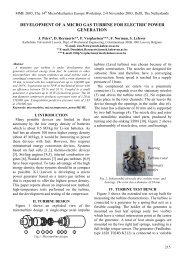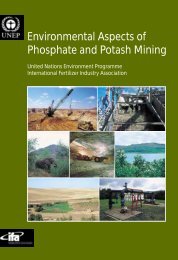demonstration of biogas production using low moisture content
demonstration of biogas production using low moisture content
demonstration of biogas production using low moisture content
You also want an ePaper? Increase the reach of your titles
YUMPU automatically turns print PDFs into web optimized ePapers that Google loves.
Conclusions<br />
CONCLUSIONS AND SUGGESTIONS FOR FURTHER ACTIVITIES<br />
Beef cattle feedlots in the Texas panhandle produce more than 6 million beef cattle annually, and the manure<br />
from these feedlots represents a tremendous <strong>biogas</strong> energy potential. This project utilized laboratory and field<br />
experiments to evaluate <strong>biogas</strong> <strong>production</strong> from beef cattle manure scraped from open lots. The field project<br />
evaluated <strong>using</strong> landfill-type cells for producing <strong>biogas</strong> from beef cattle manure. In laboratory experiments<br />
where <strong>low</strong> density polyethylene (LDPE) containers were used as mini digesters, we discovered that the<br />
containers were too permeable to gases to obtain representative <strong>biogas</strong> <strong>production</strong> rates. In modified<br />
experiments, <strong>biogas</strong> <strong>production</strong> rates reached a maximum <strong>of</strong> 0.14 liters per gram VS at a wet basis <strong>moisture</strong><br />
<strong>content</strong>s <strong>of</strong> 70%, which is <strong>low</strong>er than published values <strong>of</strong> about 0.3 liters per gram VS.<br />
In the field <strong>demonstration</strong> project, <strong>biogas</strong> was produced during a 12 week period in August through October. A<br />
total <strong>of</strong> 1,500 m 3 <strong>of</strong> <strong>biogas</strong> was produced at a rate <strong>of</strong> 0.10 liters per gram VS. While the results are promising,<br />
only producing <strong>biogas</strong> for 3 months out <strong>of</strong> the year severely limits the application <strong>of</strong> this method at beef cattle<br />
feedyards. A heated digester would produce <strong>biogas</strong> year-round, however, additional studies and engineering<br />
work are warranted to see if the landfill-cell method would be economically justifiable for use at beef cattle<br />
feedyards.<br />
REFERENCES<br />
Angelidaki, I. and B.K. Ahring. 1994 Anaerobic thermophilic digestion <strong>of</strong> manure at different ammonia leads:<br />
Effect <strong>of</strong> temperature. Water Research 28: 727-731.<br />
ASAE, 1999. Uniform terminology for rural waste management. ASAE Standard S292.5. American Society <strong>of</strong><br />
Agricultural Engineers, St. Joseph, MI.<br />
Engler, Cady R. and Marshall J. McFarland. 1997. Dairy manure digestion research and <strong>demonstration</strong> project.<br />
In Proceedings <strong>of</strong> Workshop #1, Livestock Waste Streams: Energy and Environment. pp. 64-68. Texas<br />
Renewable Energy Industries Association:Austin, TX.<br />
Hansen, Kaare Hvid, Irini Angelidaki and Birgitte Kiger Ahring. 1998. Anaerobic digestion <strong>of</strong> swine manures:<br />
inhibition by ammonia. Water Research 32:5-12.<br />
Kottwitz, D.A. and D.D. Schulte. 1982. Tumble-mix anaerobic digestion <strong>of</strong> dry beef manure. ASAE Paper<br />
Presented at the 1982 Winter Meeting, American Society <strong>of</strong> Agricultural Engineers, St. Joseph, MI.<br />
Misra, Upama, Sonjay Singh, Amarika Singh, and G.N. Pandey. 1992. A new temperature controlled digester<br />
for anaerobic digestion for <strong>biogas</strong> <strong>production</strong>. Energy Conservation Management 33:983-986.<br />
Nalgene, 1999. Physical properties <strong>of</strong> Nalgene Labware, Internet Source.<br />
Parker, D.B., B.W. Auvermann, B.A. Stewart and C.A. Robinson. 1997. Agricultural energy consumption,<br />
http://www.westbioenergy.org/cattle/conclusions.htm (1 <strong>of</strong> 2) [3/26/2003 8:52:58 AM]



